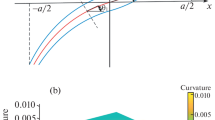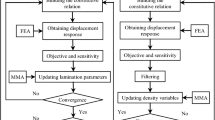Abstract
A sign optimization algorithm (SOA) is proposed to design the “±” signs in composite laminates to control the bending-twisting coupling effects. Owing to that the bending-twisting coupling stiffness are cubic on thickness, the innovation is to design the signs of ply orientations from the mid-plane to the outermost sequentially and iteratively. In this manner, the nondimensional anisotropic coefficients are controlled to the target values. Numerical examples are adopted to verify the effectiveness and efficiency of SOA. First, the signs of symmetric laminates [θ32]s are optimized with various boundaries, load ratios, and aspect ratios to show the bending-twisting coupling effects on bending, buckling, and vibration responses of composite plates. Second, the bending-twisting coupling effects are minimized since they may cause large errors in buckling load prediction when using closed-form solution after neglecting them. Third, the optimal sequences obtained from heuristic algorithms are employed for sign optimization. Results show that the bending-twisting coupling effects cannot be neglected; moreover, the buckling and vibration performances can be further improved by redesigning “±” signs in composite laminates. This research aims to provide a design technique to minimize the error induced by bending-twisting coupling and increase the probability to find the global optimum.















Similar content being viewed by others
References
An H, Chen S, Huang H (2015) Laminate stacking sequence optimization with strength constraints using two-level approximations and adaptive genetic algorithm. Struct Multidiscip Optim 51(4):903–918
An H, Chen S, Huang H (2018) Multi-objective optimization of a composite stiffened panel for hybrid design of stiffener layout and laminate stacking sequence. Struct Multidiscip Optim 57:1411–1426 1-16
Baucke A, Mittelstedt C (2015) Closed-form analysis of the buckling loads of composite laminates under uniaxial compressive load explicitly accounting for bending–twisting-coupling. Compos Struct 128:437–454
Cho M, Rhee SY (2004) Optimization of laminates with free edges under bounded uncertainty subject to extension, bending and twisting. Int J Solids Struct 41(1):227–245
Erdal O, Sonmez FO (2005) Optimum design of composite laminates for maximum buckling load capacity using simulated annealing. Compos Struct 71(1):45–52
Ferreira AJM (2008) Matlab codes for finite element analysis: solids and structures. Springer, London
Fukunaga H (1994) A laminate design for elastic properties of symmetric laminates with extension-shear or bending-twisting coupling. J Compos Mater 28(8):708–731
Fukunaga H, Sekine H, Sato M, Lino A (1995) Buckling design of symmetrically laminated plates using lamination parameters. Comput Struct 57(4):643–649
Grenestedt JL (1989a) A study on the effect of bending-twisting coupling on buckling strength. Compos Struct 12(4):271–290
Grenestedt JL (1989b) Layup optimization and sensitivity analysis of the fundamental eigenfrequency of composite plates. Compos Struct 12(3):193–209
Grenestedt JL (1990) Composite plate optimization only requires one parameter. Struct Multidiscip Optim 2(1):29–37
Grenestedt JL (1991) Layup optimization against buckling of shear panels. Struct Multidiscip Optim 3(2):115–120
Grenestedt JL, Gudmundson P (1993) Layup optimization of composite material structures. Optimal design with advanced materials. Elsevier Science Publishers, Amsterdam, pp 311–336
Haftka RT, Walsh JL (1992) Stacking-sequence optimization for buckling of laminated plates by integer programming. AIAA J 30(3):814–819
Hao P, Yuan X, Liu H et al (2017) Isogeometric buckling analysis of composite variable-stiffness panels. Compos Struct 165:192–208
Hao P, Yuan X, Liu C, Wang B, Liu H, Li G, Niu F (2018a) An integrated framework of exact modeling, isogeometric analysis and optimization for variable-stiffness composite panels. Comput Methods Appl Mech Eng 339:205–238
Hao P, Liu C, Liu X, Yuan X, Wang B, Li G, Chen L (2018b) Isogeometric analysis and design of variable-stiffness aircraft panels with multiple cutouts by level set method. Compos Struct 206:888–902
Jensen DW, Lagace PA (1988) Influence of mechanical couplings on the buckling and postbuckling of anisotropic plates. AIAA J 26(10):1269–1277
Jing Z, Fan XL, Sun Q (2015) Stacking sequence optimization of composite laminates for maximum buckling load using permutation search algorithm. Compos Struct 121(121):225–236
Jing Z, Sun Q, Silberschmidt VV (2016a) Sequential permutation table method for optimization of stacking sequence in composite laminates. Compos Struct 141:240–252
Jing Z, Sun Q, Silberschmidt VV (2016b) A framework for design and optimization of tapered composite structures part I: from individual panel to global blending structure. Compos Struct 154:106–128.26
Jing Z, Sun Q, Chen JQ, Silberschmidt VV (2018) A framework for design and optimization of tapered composite structures part II: enhanced design framework with a global blending model. Compos Struct 188:531–552
Jones RM (1999) Mechanics of composite materials, 2nd ed. Taylor and Francis, Philadelphia
Kam TY, Chang RR (1993) Design of laminated composite plates for maximum buckling load and vibration frequency. Comput Methods Appl Mech Eng 106:65–81
Kicher TP, Mandell JF (1971) A study of the buckling of laminated composite plates. AIAA J 9(4):605–613
Le Riche R, Haftka RT (1993) Optimization of laminate stacking sequence for buckling load maximization by genetic algorithm. AIAA J 31(5):951–956
Liew KM (1996) Solving the vibration of thick symmetric laminates by reissner/mindlin plate theory and the p-ritz method. J Sound Vib 198(3):343–360
Loughlan J (1999) The influence of bend–twist coupling on the shear buckling response of thin laminated composite plates. Thin-Walled Struct 34(2):97–114
Narita Y (2000) Combinations for the free-vibration behaviors of anisotropic rectangular plates under general edge conditions. Am Soc Mech Eng 67(3):568–573
Narita Y (2003) Layerwise optimization for the maximum fundamental frequency of laminated composite plates. J Sound Vib 263:1005–1016
Nemeth MP (1986) Importance of anisotropy on buckling of compression-loaded symmetric composite plates. AIAA J 24(11):1831–1835
Nemeth MP (1992a) Buckling Behavior of Long Symmetrically Laminated Plates Subjected to Combined Loadings. NASA Technical Paper 3195. NASA, Washington, D.C.
Nemeth MP (1992b) Buckling of symmetrically laminated plates with compression, shear and in-plane bending. AIAA J 30:2959–2965
Sadr MH (2012) Optimization of laminated composite plates for maximum fundamental frequency using elitist-genetic algorithm and finite strip method. J Glob Optim 54(4):707–728
Selyugin S (2013) On choice of optimal anisotropy of composite plates against buckling, with special attention to bending-twisting coupling. Struct Multidiscip Optim 48(2):279–294
Shirk MH, Hertz TJ, Weisshaar TA (1986) Aeroelastic tailoring - theory, practice, and promise. J Aircr 23(1):6–18
Stone MA, Chandler HD (1996) Errors in double sine series solutions for simply supported symmetrically laminated plates. Int J Mech Sci 38(38):517–526
Thai CH, Nguyen-Xuan H, Nguyen-Thanh N et al (2012) Static, free vibration, and buckling analysis of laminated composite Reissner mindlin plates using NURBS-based isogeometric approach. Int J Numer Methods Eng 91:571–603
Tiwari N, Hyer MW (2002) Secondary buckling of compression-loaded composite plates. AIAA J 40(10):2120–2126
Walker M, Adali S, Verijenko V (1996) Optimization of symmetric laminates for maximum buckling load including the effects of bending-twisting coupling. Comput Struct 58(2):313–319
Weaver PM, Nemeth MP (2008) Improved design formulas for buckling of orthotropic plates under combined loading. AIAA J 46(9):2391–2396
Weaver PM, Nemeth MP et al (2007) Bounds on flexural properties and buckling response for symmetrically laminated composite plates. J Eng Mech 133(11):1178–1191
York CB (2017) On bending-twisting coupled laminates. Compos Struct 160:887–900
York CB, Almeida SFMD (2018) Effect of bending-twisting coupling on the compression and shear buckling strength of infinitely long plates. Compos Struct 184:18–29
Acknowledgments
This work is supported by the Project funded by the National Natural Science Foundation of China (No. 11572134) and the Project funded by China Postdoctoral Science Foundation (No. 2017M612443).
Author information
Authors and Affiliations
Corresponding authors
Ethics declarations
Conflict of interest
The authors declare that they have no conflict of interest.
Additional information
Responsible Editor: Gengdong Cheng
Publisher’s note
Springer Nature remains neutral with regard to jurisdictional claims in published maps and institutional affiliations.
Appendix
Appendix
The laminate [308]s is adopted for the implementation of SOA. Detailed sign optimization process please see Table 10: with the sign exchanging from the mid-plane to the outermost, ω decreases gradually to a small value and then ω increases. To further decrease ω, the exchanging position turns to the mid-plane again and the above exchanging process is repeated until ω converges. The exchanged ply orientations are highlighted in grey background. Only 24 times of objective function evaluations can generate the final optimum.
Rights and permissions
About this article
Cite this article
Jing, Z., Chen, J. An investigation on design of signs in composite laminates to control bending-twisting coupling effects using sign optimization algorithm. Struct Multidisc Optim 60, 2131–2156 (2019). https://doi.org/10.1007/s00158-019-02315-6
Received:
Revised:
Accepted:
Published:
Issue Date:
DOI: https://doi.org/10.1007/s00158-019-02315-6




